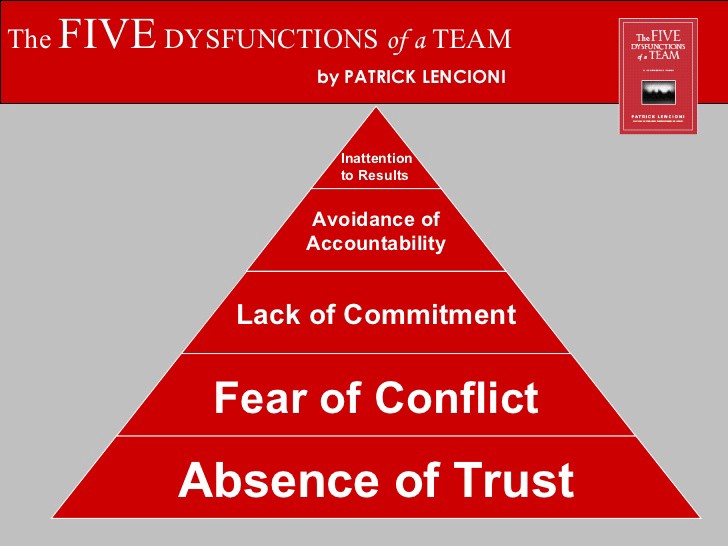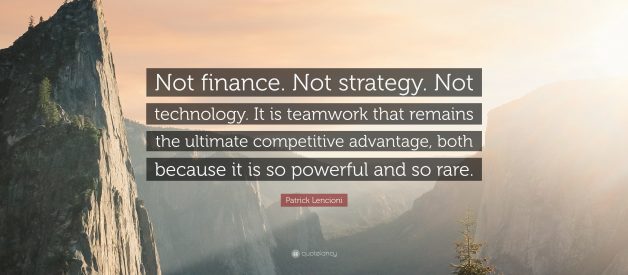The root causes of organizational politics and how to overcome them
BY JESSICA ZARTLER

Ahhhh, organizational politics. You can love watching Game of Thrones and the mental and physical chess battles that unfold, but it doesn?t mean you want to live them every day in your workplace.
We?ve all been there. Or maybe we are there now. Managing or working on a team where infighting, a lack of accountability or jockeying for position is the norm. It?s like a dysfunctional family, except worse, because you spend so much more time with your dysfunctional work family ? at least 40 hours a week.
But don?t dismay. This actually is pretty normal in most organizations, and although it isn?t easy, it is completely possible to overcome. Dysfunctional behavior on a team has very identifiable roots and with a little developed awareness, logic and communication, even the most disharmonious, ego rampant teams can row together in the boat of progress.
5 Questions
Patrick Lencioni has coached and observed thousands of CEOs and Fortune 500 management teams. And in his work as the president of management consulting firm, The Table Group, he said he saw very clear patterns in the behavioral tendencies that constituted for the majority of team breakdowns. So clear, he wrote a 229-page book about it.
 Patrick Lencioni
Patrick Lencioni
He suggests starting with these five questions about your team:
- Do your team members openly and readily disclose their opinions?
- Are your team meetings compelling and productive?
- Does your team come to decisions quickly and avoid getting bogged down by consensus?
- Do your team members confront one another about their shortcomings?
- Do your team members sacrifice their own interests for the good of the team?
If you?ve answered ?yes? to all five, you must be one incredible manager ? great job! If you have answered ?no? to any of these questions, you likely have some work to do. Read on.
The 5 Dysfunctions
Why are teams so dysfunctional? They are made up of individuals with varied interests, strengths and weaknesses. You know the saying, ?The road to hell is paved with good intentions? ? the same is true for human behavior. Even the most well-intentioned people slip into unproductive and unhealthy behavior.

Combine that with a manager who isn?t skilled in team building and guiding in this area, and bam ? dysfunctional team. But Lencioni says with knowledge, courage and discipline, teams can just as quickly become not only cohesive, but high performing.
Without further adieu:
 Lencioni?s 5 Team Dysfunctions
Lencioni?s 5 Team Dysfunctions
The five dysfunctions are stacked in a pyramid and are hierarchical, much like Maslow?s Hierarchy of Needs. Without building a strong foundation on the bottom, there is no achieving the higher level goals.
Dysfunction #1 : Absence of Trust
PROBLEM: This occurs when team members are reluctant to be vulnerable with one another and are unwilling to admit their mistakes, weaknesses, or need for help. Without a certain comfort level among team members, a foundation of trust is not possible.SOLUTION: As the manager, set the good example by asking for help from your team members, admitting your own weaknesses and limitations, and be the first to own up to a mistake. When you take the lead, others will follow. Slowly, these habits will become culture and the team will begin to build the first unshakable brick in the pyramid ? trust.
Dysfunction #2: Fear of Conflict
PROBLEM: Teams that lacktrust are incapable of engaging in unfiltered, passionate debate about key issues, causing situations where team conflict can easily turn into veiled discussions and back channel comments. In a work setting where team members do not openly air their opinions, there is a lot of posturing and precious time is wasted, resulting in inferior decisions.SOLUTION: Establish that conflict is welcome and purposeful. Define what healthy conflict looks like by praising healthy examples or giving corrective feedback if conflict veers towards unhealthy. You can also ?mine for conflict? by opening a meeting with a bad idea to see if everyone will agree to avoid conflict, and use this as a litmus test to open up healthy discussion. Lastly, you can designate a devil?s advocate in a meeting, or use pro and con lists for ideas to get people to open up to sharing a differing perspective.
Dysfunction #3: Lack of Commitment
PROBLEM: Without conflict, it is difficult for team members to commit to decisions, creating an environment where ambiguity prevails. Lack of direction and commitment can make employees, particularly star employees, disgruntled.SOLUTION: Clarity and closure are paramount to overcome this dysfunction and move to the next level. Setting clear deadlines, reviewing key decisions at the end of meetings as well as what should and should not be communicated to other staff and contingency planning can help teams overcome there fears by creating clear plans and facing potential pitfalls and the fear of failure head on so everyone can commit.
Dysfunction #4: Avoidance of Team Accountability
PROBLEM: When teams don?t commit to a clear plan of action, even the most focused and driven individuals hesitate to call their peers on actions and behaviors that may seem counterproductive to the overall good of the team. This allows for mediocrity, poor performers to slip by and the leader to become the soul source of discipline.SOLUTION: If teams have come this far, they have trust and commitment, then they will know that a team member calling them out not only has the right to do so because expectations and deadlines were clear, but that it is not a personal attack. This allows team members to confront difficult issues to hold each other accountable. Clear standards, progress reviews and team rewards are also important to make sure this area stays healthy.
Dysfunction #5: Inattention to Team Objectives
PROBLEM: Team members naturally tend to put their own needs (ego, career development, recognition, etc.) ahead of the collective goals of the team when individuals aren?t held accountable. If a team has lost sight of the need for achievement, the business ultimately suffers.SOLUTION: When teams have a solid base of trust, healthy conflict, commitment and team accountability and are recognized within the company for performance via praise or rewards, it will be easier for team members to put their own needs aside for the sake of the team. With these solutions, teams should be able to retain top performers, handle failure with resilience and stay focused.
- If you?re not the leader of the team, find a way to get your leader committed to addressing the five dysfunctions. Or be prepared to take risks calling people on unproductive behaviors. If neither of these options are possibilities, think about finding another team.
One small step for functional behavior, one giant leap for team building
You now understand and can recognize the five dysfunctions. If you would like to work more with your colleagues, Lencioni offers two free exercises you can use to begin building a more cohesive team and address these issues:
- Personal Histories ? Developing trust with low-risk vulnerability
- Team Effectiveness ? Performance feedback for developing accountability
Starting these conversations and being vulnerable with your colleagues is not always easy or comfortable, but like all relationships, it is necessary to build trust, deal with conflict, commit to each other and your goals as a team.
When you can tear down walls, build a foundation and synergy, you will benefit not only from collective progress and rewards, but a more enjoyable atmosphere to spend 40+ hours a week.
One of the best ways to avoid dysfunction in the workplace is to have clear deadlines and goals, communicate effectively and maintain accountability. Project management software makes this simple, and has been proven to increase the cohesion and performance of teams.

About the author

Jessica Zartler is an international Multimedia Marketing Consultant & Content Strategist for Taskworld. Before consulting, she was an award-winning television reporter and multimedia journalist for eight years. When she is not hunting for the best content on the web to share with TW users, blogging or producing videos, she is teaching yoga, researching and contributing to blockchain projects, cooking, playing drums and travelling.


